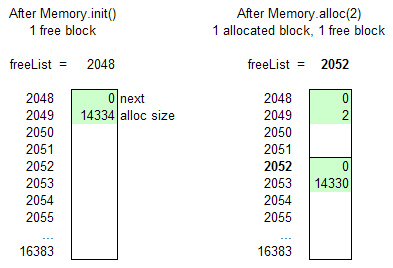kraftwerk1611 wrote
* How many static arrays do we need to implement these surboutines? The book chapter 12 and lectures refer to several arrays. Are ram, heap, freelist, block are all arrays? Are freelist and heap different names for same array?
*Do we have to use an array named 'ram' that is initialised as
let ram=0;
Why do we need this array?
There are no static arrays used in implementing the heap. It is convenient, however, to have a single "static Array ram" that is initialized to 0 as the first thing in Memory.init(). Doing this effectively extends the Jack language so that you can use
ram[addr]
to read and write directly to the RAM memory.
*The linked list in book as size as the first element of memory segment, while lecture have 'next' pointer as first element of memory segement? Does it matter, which one we choose? The commands like
let heap[0]=0;
let heap[1]=14335;
show that first element in linked list is next pointer.
To make things clearer, refer to the two parts of the heap segments as the
segment header and the
user data.
It does not matter which order the two values in the segment header. It also does not matter if the size in the segment header is the total segment size or the user data size, as long as your code is self-consistent.
The book uses size first/segment size, and the videos present next first/user size.
NOTE: There is a typo in the videos. heap[1] should be set to 14334, the total size of the heap - 2 words for the header.
*Is it right that value stored in variable 'heap' on stack will remain fixed at 2048 but value stored in 'freelist' on stack will keep changing?
Is it so that initially freelist=2048 but it will keep changing?
*Should we think of 'heap' array as something different from the actual Heap memory segment [2048...16383] and one that is managed separately as a linked list only?
*My main confusion is about what happens after ver first call to alloc(). The book page 255 show state of memory after several alloc() and dealloc() calls.
If at the very beginning we have
heap[0]=ram[2048]=0
heap[1]=ram[2049]=14335
Then if the firt allocation request is alloc(2), then what happens to the heap memory segement and heap array?
Is it so that now first 4 memory addresses in heap memory area[2048...2051] will not be available anymore? Will the values stored in array heap, heap[0] and heap[1] need to be updated now to heap[0]=2052 and heap[1]=14331 or do we leave heap[0] and heap[1] untouched and update some other variable or heap array elements.
*If 'heap' array is something different from heap memory and is maintained separately does it only start building up after first dealloc() is called as before that whole memory is available for use and we can simply keep allocating memory blocks to alloc() calls.
freeList needs to be a static variable so that both alloc() and deAlloc() can use it.
heap is a local variable only used in init().
segment is a local variable used in alloc() and deAlloc().
Since the values stored in
freeList and the next pointer in the segment header are RAM addresses, there is no need for the
heap variable in alloc() or deAlloc().

* The last element of linked list should point to 'null'. Does it also apply only when first dealloc() has been called?
* Which address is returned by alloc()? Is this the first address of whole memory segment including size and next pointer or is it the address after size and next elements?
In case of alloc(2) as the very first call, will the returned value be 2048 or 2050?
The link in the last element of a linked list should always be null. There is a special case when the list is empty, then the
freeList value itself will be null.
The values returned by the alloc() call are the address of the user data, so in this case that would be 2050.
Note that since deAlloc is called by the user with the address that was returned by alloc(), that address needs to be adjusted to get the heap segment address that is to be freed:
deAlloc(object) {
var Array segment;
let segment = object-2; // size of segment header
Also note in deAlloc() that it makes no difference if the deallocated segment is added to the beginning or the end of the free list. The book and video show adding it to the end, but it is easier to add it to the beginning of the free list.



